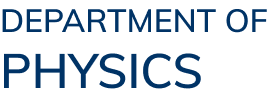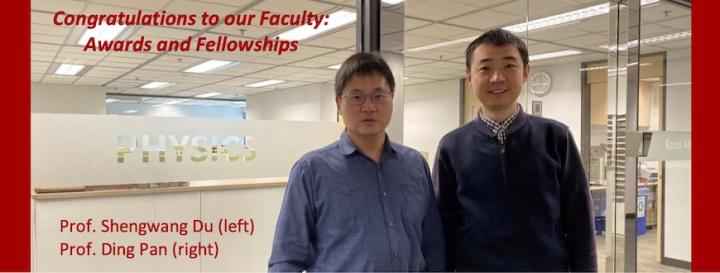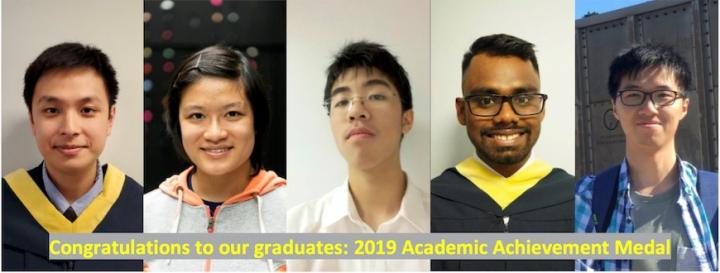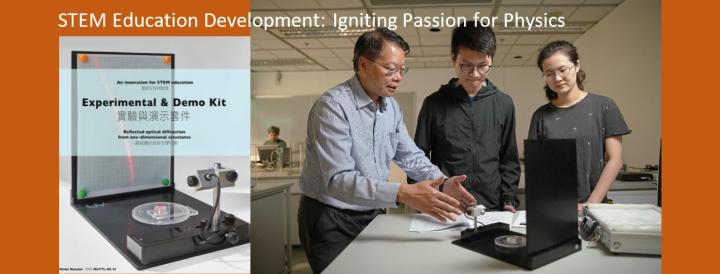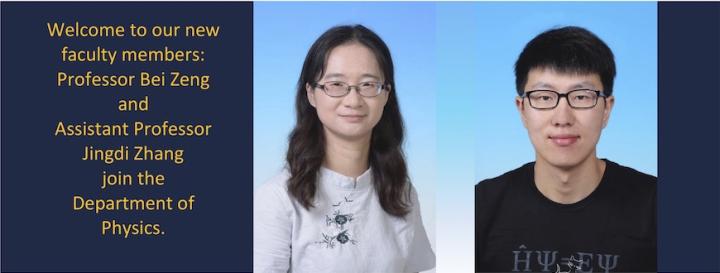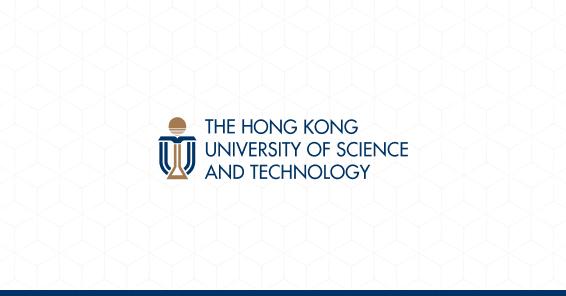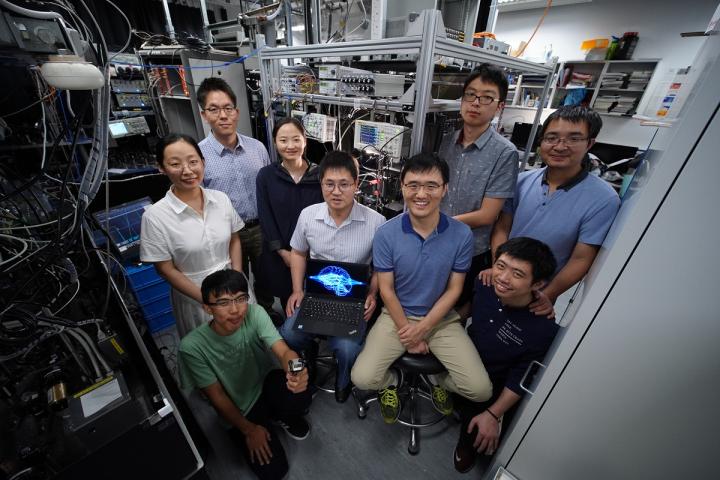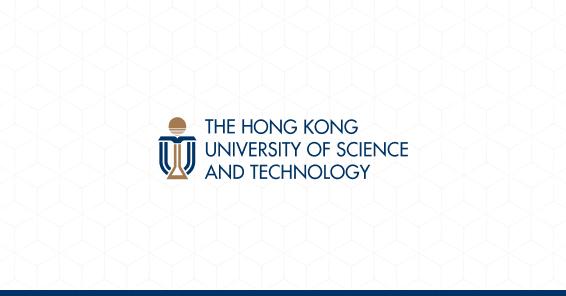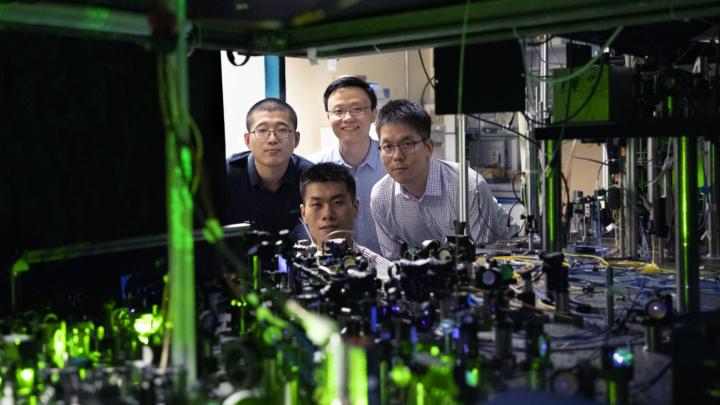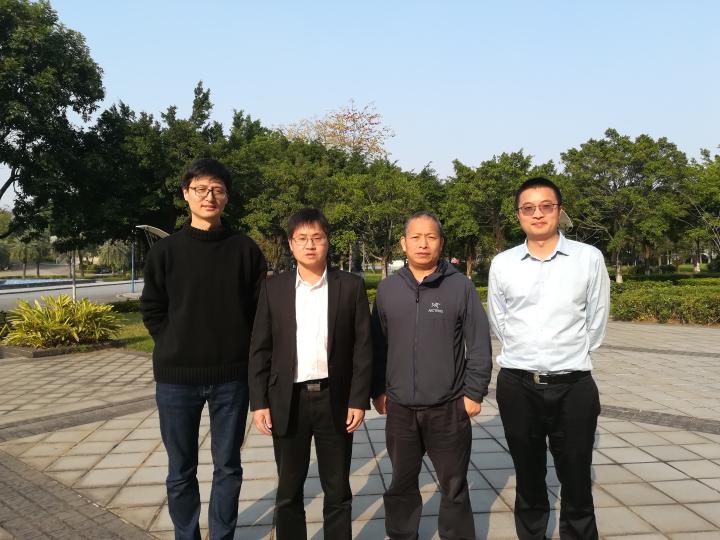News & Events
2019-11-22
Congratulations to faculty members in the Department of Physics for important recognition of their research achievements.
Prof. Shengwang Du (left) was elected Fellow of the American Physical Society (APS) upon nomination by the Division of Atomic, Molecular and Optical Physics. Prof. Du was cited “for significant contributions to photon-atom quantum interaction, including generation and manipulation of narrowband biphotons, and for the realization of efficient quantum memory, observation of optical precursors, and demonstration of nontraditional quantum heat engines.” The APS Fellowship Program was established to recognize members who have made exceptional contributions to the physics enterprise through outstanding research, leadership or service, or application of physics to science and technology. Each year, no more than 0.5% of the total APS membership is elected for Fellowship after a rigorous and competitive review process.
Prof. Ding Pan (right) was the recipient of a Deep Carbon Observatory Emerging Leader Award in 2019. The Deep Carbon Observatory (DCO) is a global community of more than 1000 scientists whose quest is to understand the quantities, movements, forms and origins of carbon in Earth with support from the Sloan Foundation. These DCO awards honor early career researchers for their distinguished performance and unique potential as leaders of the deep carbon science community. The awards have been bestowed on two to four outstanding early career scientists each year since 2015. The 2019 recipients were selected through a highly competitive process.
Read more
2019-11-13
Congratulations to Long Him Cheung, Wan Zhen Chua, Mang Hei Gordon Lee, Gowtham Amirthya Neppoleon and Lingbang Zhu (l-r) for being awarded 2019 Academic Achievement Medals. The Academic Achievement Medal is the highest academic honor bestowed by the University on outstanding undergraduate students upon graduation. The awarding of the Medal was established in 1994 to recognize graduates whose outstanding academic achievements bring honor and distinction both to themselves and to the University. Only the top 2-3% of graduates are awarded the Academic Achievement Medal annually. These awards were presented at the 27th University Congregation on 8 November 2019. We are proud of all of our graduates, and are especially delighted in the achievements of the Academic Achievement Medal awardees.
Mr. Cheung is pursuing a PhD degree in Physics at the University of Maryland. Ms. Chua is pursuing a MSc degree in theoretical physics within the Perimeter Scholars International Program at the Perimeter Institute. Mr. Lee is pursuing a MASt degree in Applied Mathematics at Cambridge University. Mr. Neppoleon is pursuing the MPhil degree in Physics at HKUST. Mr. Zhu is pursuing the PhD degree in Chemical Physics at Harvard University.
Read more
2019-10-17
The Department of Physics is proud to welcome two new faculty members:
Assistant Professor Jingdi Zhang received his Bachelor’s degree at University of Science and Technology of China, and Ph.D. in Physics at Boston University. Prior to joining HKUST, he was a postdoctoral researcher at UC San Diego. His research interest is using state-of-the-art ultrafast pump-probe spectroscopy to interrogate and control non-equilibrium dynamics of quantum materials and artificial materials, through light-matter interaction on femtosecond (10-15 s) to picosecond (10-12 s) timescale.
Professor Bei Zeng receive her Ph.D. in Physics at the Massachusetts Institute of Technology. Prior to joining HKUST, she was Professor in the Department of Mathematics and Statistics at the University of Guelph and Affiliate Faculty at the Perimeter Institute for Theoretical Physics. Prof. Zeng’s research focuses on information processing and computing based on quantum effects such as superposition and entanglement.
Read more
2019-10-16
The Department of Physics sets Service Award for Undergraduate Physics Students to promote the spirit of service among the Physics students. Priority will be given to those who served their fellow Physics students, the Physics Department, or the community in the capacity of Physics students. The total amount of the award is up to HK$20,000 annually.
We are pleased to announce that the 2019 Physics Service Award will be given to Wai Ki WONG.
Wai Ki WONG (3rd year Physics UG student) 2019 Physics Service Award
“For his outstanding service and leadership in the initiative of forming the new Physics Students’ Association.”
For the details of the award, please check the HKUST Physics UG Scholarship website: http://physics.ust.hk/scholarship/index.html
Congratulations to our students for their achievements.
Sincerely yours,
Prof. Penger Tong
Head, Department of Physics
The Hong Kong University of Science and Technology
Read more
2019-10-09
Following the announcement of the Nobel Prize in Physics 2019, the Physics Department is pleased to announce that the 2019 Paul and May Chu Undergraduate Research Award is awarded to Bohan LI, and the Honorable Mention is awarded to King Chun WONG. The Paul and May Chu UG Research Award is the highest honor offered by the Department to recognize outstanding research in physics conducted by an undergraduate student.
Bohan LI, winner of 2019 Paul and May Chu UG Research Award
4th year Physics UG student
“For the experimental demonstration of all-optical neural network and realization of optical Eratosthenes’ sieve,” under the supervision of Profs. Shengwang DU (HKUST) and Alex LVOVSKY (Oxford).
Bohan LI has worked on experimental quantum optics under the supervision of Prof. Shengwang Du since May 2017. He made a significant contribution to the realization of all-optical neural network with nonlinear activation functions [Optica 6, 1132 (2019); News Release of The Optical Society on 29/08/2019]. During his three-month summer research with Prof. Alex Lvovsky at University of Oxford, he demonstrated optical Eratosthenes’ sieve by contributing both essential ideas and hard instrumental work.
King Chun WONG, Honorable Mention of 2019 Paul and May Chu UG Research Award
4th year Physics UG student
“For the understanding of influence spreading dynamics in complex networks,” under the supervision of Prof. Kwok Yip SZETO (HKUST).
King Chun WONG has worked for three years on complex system dynamics under the supervision of Prof. Kwok Yip Szeto. His work on influence spreading dynamics in complex networks was published in the Proceeding of The International Conference on Distributed Computing and Artificial Intelligence (DCAI 2019: Advances in Intelligence Systems and Computing, vol. 1003) and won the best paper award.
For details about the award, please check the HKUST Physics UG Scholarship website:http://www.phys.ust.hk/scholarship/
Congratulations to Bohan LI and King Chun WONG!
Sincerely yours,
Prof. Penger TONG
Head, Department of Physics
The Hong Kong University of Science and Technology
Award Selection Panel: Profs. Jason Z.Y. YANG, Hyokeun PARK, and Bei ZENG
Read more
2019-08-28
Dear physics students,
If you ever wonder how the physics knowledge you learned can change the world, you may be interested in the new courses introduced in Fall 2019 under the collective title Contemporary Applications of Physics:
PHYS 4811 - Contemporary Applications of Physics: Machine Learning in Physics (1 unit)
PHYS 4812 - Contemporary Applications of Physics: Quantum Information Technology (1 unit)
PHYS 4813 - Contemporary Applications of Physics: Atmospheric Physics - Making Sense of Weather and Climate (1 unit)
These 1 unit courses share the same lecture-tutorial time slots but each runs for 4 weeks only in a sequential manner. They are mutually independent and you can take any one, two or three of them in the same term.
Course website link:
https://prog-crs.ust.hk/ugcourse/2019-20/PHYS Feel free to email or talk to the instructors if you have any question concerning these courses. Instructor contact information: PHYS 4811 – Fall 2019-20 Course Instructor: Prof. Tao LIU (Email: taoliu@ust.hk) PHYS 4812 – Fall 2019-20 Course Instructor: Prof. Gyu-Boong JO (Email: gbjo@ust.hk) PHYS 4813 – Fall 2019-20 Course Instructor: Dr. Sai Kit CHEUNG (Email: leoncheungsk@ust.hk) Thank you for your attention. Department of Physics, HKUST Read more
If you ever wonder how the physics knowledge you learned can change the world, you may be interested in the new courses introduced in Fall 2019 under the collective title Contemporary Applications of Physics:
PHYS 4811 - Contemporary Applications of Physics: Machine Learning in Physics (1 unit)
PHYS 4812 - Contemporary Applications of Physics: Quantum Information Technology (1 unit)
PHYS 4813 - Contemporary Applications of Physics: Atmospheric Physics - Making Sense of Weather and Climate (1 unit)
These 1 unit courses share the same lecture-tutorial time slots but each runs for 4 weeks only in a sequential manner. They are mutually independent and you can take any one, two or three of them in the same term.
Course website link:
https://prog-crs.ust.hk/ugcourse/2019-20/PHYS Feel free to email or talk to the instructors if you have any question concerning these courses. Instructor contact information: PHYS 4811 – Fall 2019-20 Course Instructor: Prof. Tao LIU (Email: taoliu@ust.hk) PHYS 4812 – Fall 2019-20 Course Instructor: Prof. Gyu-Boong JO (Email: gbjo@ust.hk) PHYS 4813 – Fall 2019-20 Course Instructor: Dr. Sai Kit CHEUNG (Email: leoncheungsk@ust.hk) Thank you for your attention. Department of Physics, HKUST Read more
